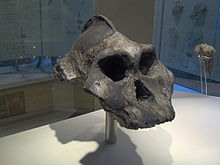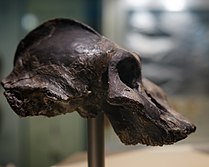Paranthropus aethiopicus
| Paranthropus aethiopicus | |
|---|---|

| |
| Reconstruction of KNM WT 17000 | |
| Scientific classification | |
| Domain: | Eukaryota |
| Kingdom: | Animalia |
| Phylum: | Chordata |
| Class: | Mammalia |
| Order: | Primates |
| Suborder: | Haplorhini |
| Infraorder: | Simiiformes |
| Family: | Hominidae |
| Subfamily: | Homininae |
| Tribe: | Hominini |
| Genus: | †Paranthropus |
| Species: | †P. aethiopicus
|
| Binomial name | |
| †Paranthropus aethiopicus | |
| Synonyms | |
Paranthropus aethiopicus is an
Like other Paranthropus, P. aethiopicus had a tall face, thick palate, and especially enlarged cheek teeth. However, likely due to its archaicness, it also diverges from other Paranthropus, with some aspects resembling the much earlier A. afarensis. P. aethiopicus is known primarily by the skull KNM WT 17000 from Koobi Fora, Lake Turkana, Kenya, as well as some jawbones from Koobi Fora; the Shungura Formation, Ethiopia; and Laetoli, Kenya. These locations featured bushland to open woodland landscapes with edaphic (water-logged) grasslands.
Taxonomy
Research history

In 1968, French palaeontologist Camille Arambourg and Breton anthropologist Yves Coppens described "Paraustralopithecus aethiopicus" based on a toothless mandible (Omo 18) from the Shungura Formation, Ethiopia. The name aethiopicus refers to Ethiopia.[2] In 1976, American anthropologist Francis Clark Howell and Coppens reclassified it as A. africanus.[3]
In 1985, the skull KNM WT 17000 dating to 2.5 million years ago was reported from Koobi Fora, Lake Turkana, Kenya, by anthropologists Alan Walker and Richard Leakey. A partial jawbone from a different individual, KNM-WT 16005, was also discovered. They clearly belonged to a robust australopithecine.[4] By this point in time, much younger robust australopithecines had been reported from South Africa (robustus) and East Africa (boisei), and been variously assigned to either Australopithecus or a unique genus Paranthropus.[5] Walker and Leakey assigned KNM WT 17000 to the boisei clade. They noted several anatomical differences, but were unsure if this stemmed from the specimens' archaicness or represented the normal range of variation for the species. If the former, they recommended classifying them and similar specimens into a different species, aethiopicus (and recommended that Paraustralopithecus be invalid). The discovery of these archaic specimens overturned previous postulations that P. robustus was the ancestor of the much more robust P. boisei (a hypothesis notably argued by palaeoanthropologist Yoel Rak in 1985) by establishing the boisei lineage as beginning long before robustus had existed.[4]
In 1989, palaeoartist Walter Ferguson recommended KNM WT 17000 be classified into a different species, walkeri, because the holotype of aethiopicus comprised only the jawbone and KNM WT 17000 preserves no jaw elements.[3] Ferguson's classification is almost universally ignored,[6] and is considered to be synonymous with P. aethiopicus.[7]
Several more lower and upper jaw specimens have been unearthed in the Shungura Formation,[5]: 112–113 including a juvenile specimen, L338y-6.[8] In 2002, a 2.7–2.5 Ma maxilla, EP 1500, from Laetoli, Tanzania, was assigned to P. aethiopicus. Also found was the upper portion of a tibia, but it cannot definitively be associated with EP 1500 and thus with P. aethiopicus.[9]
Classification
The genus Paranthropus (from
It is also debated if Paranthropus is a valid natural grouping (
|
|
|
This species, originally named Paraustralopithecus aethiopicus, cannot retain the species epithet aethiopicus if moved to genus Australopithecus because Australopithecus aethiopicus is already a junior synonym of Australopithecus afarensis. Such a classification would have to use the name Australopithecus walkeri for this species. The change of species epithet would also happen in a taxonomy that classifies all hominins as Homo.[14]
Description
Typical of Paranthropus, KNM WT 17000 is heavily built, and the

KNM-WT 16005 is quite similar to the
Many of these P. aethiopicus features are shared with the early A. afarensis, further reiterating the species' archaicness.[4][8]
Palaeoecology
In general, Paranthropus are thought to have been generalist feeders, with the heavily built skull becoming important when chewing less desirable, lower quality foods in times of famine. Unlike P. boisei which generally is found in the context of closed, wet environments, P. aethiopicus seems to have inhabited bushland to open woodland habitats around edaphic (water-logged) grasslands.[5]: 121 Around 2.5 million years ago, at the Pliocene/Pleistocene border, the Omo–Turkana Basin featured a mix of forests, woodlands, grasslands, and bushlands, though grasslands appear to have been expanding through the Early Pleistocene. Homo seems to have entered the region 2.5–2.4 million years ago.[15]
See also
- African archaeology – Archaeology conducted in Africa
- Australopithecus garhi – Extinct hominid from the Afar Region of Ethiopia 2.6–2.5 million years ago
- Australopithecus afarensis – Extinct hominid from the Pliocene of East Africa
- Australopithecus africanus – Extinct hominid from South Africa
- Homo habilis – Archaic human species from 2.8 to 1.65 mya
- Homo rudolfensis – Extinct hominin from the Early Pleistocene of East Africa
- LD 350-1 – Earliest known specimen of the genus Homo
- Paranthropus boisei – Extinct species of hominin of East Africa
- Paranthropus robustus – Extinct species of hominin of South Africa
References
- ^ or Australopithecus walkeri as the former combination is preoccupied by a junior synonym of Australopithecus afarensis
- ^ Arambourg, C.; Coppens, Y. (1968). "Sur la decouverte dans le Pleistocene inferieur de la valle de l'Omo (Ethiopie) d'une mandibule d'Australopithecien" [On the discovery in the Lower Pleistocene Omo Valley (Ethiopia) of an Australopithecine Mandible]. Comptes Rendus des Séances de l'Académie des Sciences (in French). 265: 589–590.
- ^ S2CID 28642451.
- ^ S2CID 4270200.
- ^ PMID 18046746.
- ISBN 978-1-4443-4247-5.
- ISBN 978-0-385-46792-6.
- ^ PMID 7802091.
- ^ Harrison, T. (2002). "The first record of fossil hominins from the Ndolanya Beds, Laetoli, Tanzania". American Journal of Physical Anthropology. 32: 83.
- ^ "Paranthropus". Merriam–Webster Dictionary. Retrieved 20 June 2020.
- S2CID 53574805.
- PMID 31182201.
- ^ McNulty, K. P. (2016). "Hominin Taxonomy and Phylogeny: What's In A Name?". Nature Education Knowledge. 7 (1): 2.
- PMID 10600324.
- ISBN 978-1-4020-9980-9.
External links
 Media related to Paranthropus aethiopicus at Wikimedia Commons
Media related to Paranthropus aethiopicus at Wikimedia Commons- Human Timeline (Interactive) – Smithsonian, National Museum of Natural History (August 2016).


